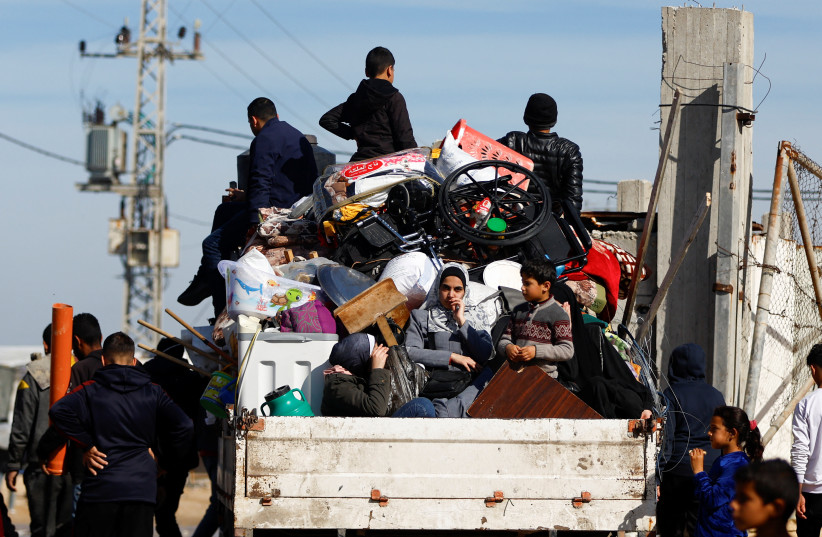Hamas stronghold in Rafah is key to its survival in Gaza
Hamas has been defeated in many parts of the Gaza strip. This is particularly true in terms of Hamas battalions, the organizational tactical level unit that it has used to control areas in Gaza. Of 24 Hamas battalions, it is believed more than 18 have been defeated or destroyed.
However, Hamas continues to rule in Rafah, a key area on the Egyptian border where it controls humanitarian aid that enters Gaza.
For Hamas the control of Rafah is of the utmost importance. It wants to have a stranglehold on aid and also control other types of items, such as smuggled goods or arms stockpiles, which Egypt sought to stop.
The region is now awaiting the likelihood of a struggle for Rafah. Al-Ain media in the UAE reported on February 7 that Israel has made preparations for operations in Rafah and asks, “Has the countdown begun?” The report said “Fears have been increasing for several days about an Israeli attack.”
Al-Jazeera in Qatar, where key Hamas leaders live, also reported that the UN has said “everything possible” must be done to avoid an Israeli attack on Rafah. The New Arab, an online media outlet, said that Egypt has warned that Israeli moves there could jeopardize the peace treaty.
Overcrowding in Gaza’s southernmost city
For some commentators, the humanitarian issue of overcrowding in the city by Gazans who fled fighting elsewhere is very important. However, it’s not clear why so many people fled to Rafah when they could also go to the humanitarian zone in Gaza near the coast, called Al-Mawasi. Hamas benefits from having a large number of internally displaced people in Rafah that it can use as human shields.

Hamas wants to survive, having lost control of other areas in Gaza. It has tried to infiltrate gunmen into northern Gaza and has also sought to maintain civil control in the north. However, when it comes to its actual terrorist units, it has suffered many losses.
Even as it loses ground, its demands for a hostage deal have grown. It wants an extended ceasefire and a three-phase release of hostages in return for prisoners in Israel, followed by an end to the war. It has demanded an end to Israeli surveillance, more aid and more support for reconstruction.
This has been the Hamas plan all along. It wanted to hide for a few months and watch as international pressure built up on Israel, and then re-emerge as it has done after previous wars in 2009, 2012, 2014, and 2021.
For Hamas, holding on to Rafah is key. It needs to control humanitarian aid because this is how it controls the people of Gaza. It has worked over the years to create a symbiotic partnership with international organizations, so that it is able to build tunnels and store weapons throughout Gaza and it outsources much of the aid work aboveground to internationals. In this way Hamas benefits and the international organizations also benefit because they get to claim they are responsible for helping people.
A telling Guardian article on January 30, reveals the role of Hamas in relation to international organizations. It notes that “a senior UN official described Rafah, the southernmost town in Gaza, as ‘the last remaining place with any real civil order’ due to the presence of local Hamas police.” Notice how Hamas, which committed a genocidal attack on Israel, massacring civilians and dragging hostages back to Gaza, is presented as “civil order.” The terrorist group that stores rockets and weapons in schools and homes, is “civil order.”
The article reveals more of this trend of Hamas being portrayed in a positive light by international organizations that work with and rely on it. “Hamas administrators and police maintain firm control of the south, where much of the population is concentrated, though civil order is breaking down in central regions,” the article notes. A “senior humanitarian official” told The Guardian that “You still see Hamas police in different areas who have a grip to some extent on law and order in some places, including in the north.” Hamas, which launched a war on Israel and has brought destruction on Gaza and runs it as an authoritarian state is portrayed as “law and order.” It’s clear the international organizations have a preference for Hamas rule.
The article goes on to note that “aid agencies trying to distribute food, fuel and other essentials to the displaced in southern Gaza continue to deal with Hamas-appointed officials. Hamas still provides police escorts for convoys.” Another international organization member of the International Committee of the Red Cross in Gaza is quoted as saying “there is a generalized breakdown of law and order. Criminality overall is increasing.” Note here, that Hamas which holds hostages in tunnels underground is not described as “criminality,” rather it is other Gazans.
Hamas is often praised in these Guardian accounts for providing “aid convoys” with “armed escorts.” One quote notes “aid convoys are receiving armed escorts. It is unclear if these are Hamas police, who are still present and visible, or private security companies. There is a fine line between where one starts and the other stops.”
The portrayal here of Hamas as the “law and order” in Gaza and the positive spin it receives for putting armed men in charge of humanitarian aid is key to understanding how the Hamas stranglehold on Rafah keeps it in power. Hamas must control the spigot to continue working with various international organizations. Hamas and these organizations have become mutually dependent. The Hamas one-party terror state lets the agencies operate and in return, like a mafia selling protection, they put armed men around humanitarian aid convoys.





Comments are closed.